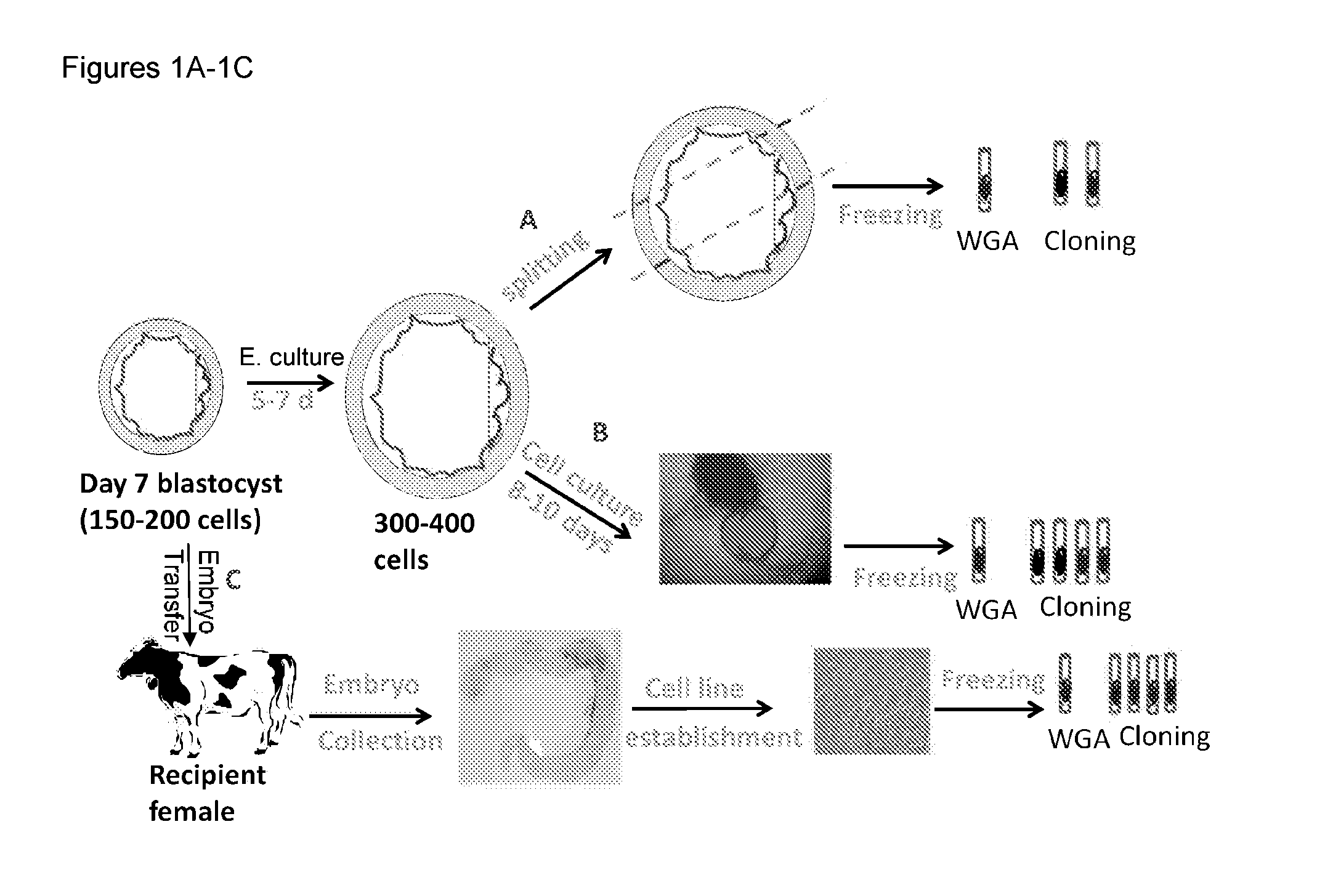Methods for generating genetically superior animals
a technology of genetic superiority and methods, applied in the field of methods for animal production, can solve the problem of very low rate of obtaining superior animals from these offspring
- Summary
- Abstract
- Description
- Claims
- Application Information
AI Technical Summary
Benefits of technology
Problems solved by technology
Method used
Image
Examples
example 1
Whole Embryo Culture in vitro and Splitting of Embryos
[0048]Oocytes were collected from pre-pubertal heifers. Following a 7-day culturing window that is standard practice in the field, embryos were cultured in vitro for an additional 5-7 days in standard embryo culture medium (e.g., synthetic oviductal fluid (SOF), e.g., SOF with amino acids, sodium citrate, and myo-inositol (SOFaaci)) with 15% Fetal calf serum. At this stage, each embryo contained approximately 300-400 cells (FIG. 1). These embryos were divided into three aliquots using micromanipulation techniques (FIG. 1A). The three aliquots were frozen separately in freezing medium (EC2 with 20% DMSO and 60% FCS) and stored in liquid nitrogen for further downstream analysis and usage.
[0049]Using the method described above, several aliquots of cells from the same embryo are generated. One or more of these aliquots are used for whole genome analysis (WGA) or other types of genetic analysis (FIG. 1A). Based on the results of the g...
example 2
Extended Culture of Whole Embryo in vitro
[0050]Jersey females were super-ovulated, and oocytes aspirated and matured in vitro per standard protocols. After maturation, oocytes were inseminated in vitro using semen from different Jersey bulls. After fertilization, presumptive zygotes were cultured for 7-8 days. Expanded blastocyst stage embryos were then selected and cultured individually in multi-well plates containing modified tissue culture medium without any feeder cells for approximately 10 days (see FIG. 1B). Once the cultured embryos were attached to the surface of the tissue culture plate and started to divide, the culture media was replaced once every 4 days until cell colony monolayers were established. Table 1 below shows the number of cell lines established with cultured whole Jersey embryos using this method.
TABLE 1Cell line establishment with Jersey embryosDate of oocyteSire / donorNo. of embryosNo. of cell linesaspirationcombinationculturedestablished in 8-10 daysMar. 22...
example 3
Embryo Transfer to Recipient Mothers
[0053]Jersey females were super-ovulated, and oocytes aspirated and matured in vitro per established protocols. After maturation, oocytes were inseminated in vitro using semen from different Jersey bull. After fertilization, presumptive zygotes were cultured for seven days. On day 7, embryos were selected, graded, and transferred to a recipient mother, with each recipient mother receiving 3-5 embryos (1-3 embryos per uterine horn).
[0054]Embryos were collected between pregnancy days 21-26. Briefly, recipient mothers were confined in a cattle chute and given an epidural block of 2% procaine. A sterile 24-gauge Foley catheter was inserted through the cervix into the uterine body and ViGro complete flush solution (Bioniche Animal Health Inc., Pullman, Wash.) supplemented with 16 μl / ml of antibiotic-antimycotic (Gibco, Grand Island, N.Y.) and 8 μl ml fungizone (Gibco, Grand Island, N.Y.) was flushed through the uterus non-surgically. Upon recovery, emb...
PUM
| Property | Measurement | Unit |
|---|---|---|
| time | aaaaa | aaaaa |
| time period | aaaaa | aaaaa |
| freezing | aaaaa | aaaaa |
Abstract
Description
Claims
Application Information
 Login to View More
Login to View More - R&D
- Intellectual Property
- Life Sciences
- Materials
- Tech Scout
- Unparalleled Data Quality
- Higher Quality Content
- 60% Fewer Hallucinations
Browse by: Latest US Patents, China's latest patents, Technical Efficacy Thesaurus, Application Domain, Technology Topic, Popular Technical Reports.
© 2025 PatSnap. All rights reserved.Legal|Privacy policy|Modern Slavery Act Transparency Statement|Sitemap|About US| Contact US: help@patsnap.com


